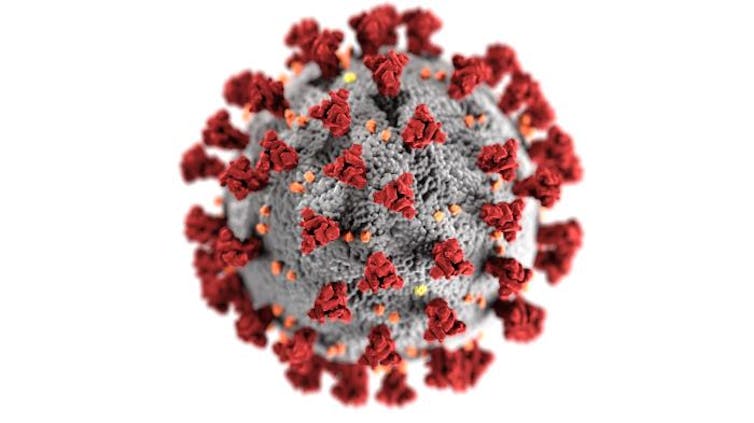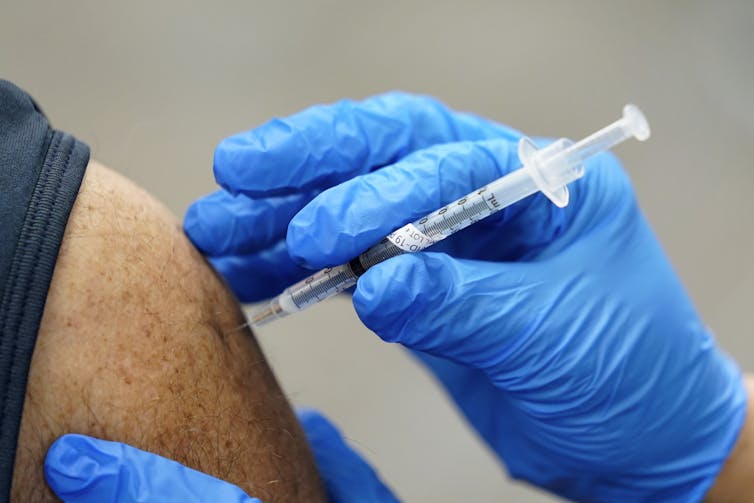
Experts in autocracies have pointed out that it is, unfortunately, easy to slip into normalizing the tyrant, hence it is important to hang on to outrage. These incidents which seem to call for the efforts of the Greek Furies (Erinyes) to come and deal with them will, I hope, help with that. As a reminder, though no one really knows how many there were supposed to be, the three names we have are Alecto, Megaera, and Tisiphone. These roughly translate as “unceasing,” “grudging,” and “vengeful destruction.”
It would appear to be time for us and the Furies to join the conversation about vaccines. I know some here have been fully vaccinated, and some partially. I have not really even looked yet, because it’s no hardship for me to stay isolated (no family that need hugs, a dependable routine, etc.), it’s still pretty cold (it warms up for a few days and then gets cold again), and I have had other things to think about. I certainly intend to get vaccinated (during out window of warmth) and will pursue it aggressively as soon as that happens. And it will most likely be with an mRNA vaccine, since those are the ones in greatest supply – and I expect everyone here who has been vaccinated has had one of those also. But probably without being aware of how revolutionary they are.
================================================================
How do mRNA vaccines work – and why do you need a second dose? 5 essential reads

Andriy Onufriyenko/Moment via Getty Images
Daniel Merino, The Conversation
Tens of millions of people across the U.S. have received a coronavirus vaccine. So far, the majority of doses have been either the Moderna or Pfizer vaccine, both of which use mRNA to generate an immune response. These gene-based vaccines have been in the works for decades, but this is the first time they have been used widely in people.
MRNA vaccines are proving to be more effective than anyone had hoped, but as with any new medical advancement, people have a lot of questions. How do they work? Are they safe? Do I really need two shots? Why do they need to be kept so cold? And will this be the vaccine technology of the future? Below, we highlight five articles from The Conversation that will help answer your questions about mRNA vaccines.
1. A vaccine revolution
“DNA and mRNA vaccines offer huge advantages over traditional types of vaccines, since they use only genetic code from a pathogen – rather than the entire virus or bacteria,” writes Deborah Fuller, a microbiologist at the University of Washington who has been working on gene-based vaccines for decades.
The Moderna and Pfizer vaccines are proof that mRNA vaccines are ready for prime time – and far surpass their predecessors. “The hopes that gene-based vaccines could one day provide a vaccine for malaria or HIV, cure cancer, replace less effective traditional vaccines or be ready to stop the next pandemic before it gets started are no longer far-fetched,” explains Fuller.
2. How does an mRNA vaccine work?
These vaccines are not only effective, they work in a fundamentally different way from traditional vaccines, explains Sanjay Mishra, a staff scientist at the Vanderbilt University Medical Center.
Traditional vaccines use an entire dead virus – or just a piece of one – to generate immunity. “But an mRNA vaccine is different,” writes Mishra, “because rather than having the viral protein injected, a person receives genetic material – mRNA – that encodes the viral protein. When these genetic instructions are injected into the upper arm, the muscle cells translate them to make the viral protein directly in the body.”

CDC/Alissa Eckert, MSMI; Dan Higgins, MAMS
3. Quick to market, but still safe
“Safety is the first and foremost goal for a vaccine,” says William Petri, a Professor of Medicine at the University of Virginia. A lot of people have expressed safety concerns based on how fast these vaccines were developed, approved and distributed.
According to Petri, the vaccines still went through every normal step – they just did them simultaneously.
“In my opinion, safety is not compromised by the speed of vaccine development and emergency use authorization. The reason that vaccines may be approved so quickly is that the large clinical trials to assess vaccine efficacy and safety are happening at the same time as the large-scale manufacturing preparation, funded by the federal government’s Operation Warp Speed program.”
4. Why it’s important to get your second shot
You got your first vaccine shot. But with shortages and supply problems, getting the second dose might be becoming a hassle. Does it really matter? Yes, explains William Petri in another article.
“The first dose primes the immune system and introduces the body to the germ of interest. This allows the immune system to prepare its defense. The second dose, or booster, provides the opportunity for the immune system to ramp up the quality and quantity of the antibodies used to fight the virus.”
Immunity is a complex process, and “if the booster isn’t given within the appropriate window, lower quantities of antibodies will be produced that may not provide as powerful protection from the virus,” writes Petri. So go get your second shot if you can, even if you have to get it a bit later than expected.

AP Photo/Paul Sancya
5. Subzero storage makes distribution a challenge
For all of their amazing attributes, mRNA vaccines do have at least one weakness: “If they get too warm or too cold they spoil. And, just like fish, a spoiled vaccine must be thrown away,” explains Anna Nagurney, Professor of Operations Management at the University of Massachusetts, Amherst, who studies medical supply chains.
The mRNA molecule is very fragile, so vaccines need to be kept at extremely cold, very specific temperatures – a challenge for distribution. “The answer is something called the vaccine cold chain – a supply chain that can keep vaccines in tightly controlled temperatures from the moment they are made to the moment that they are administered to a person,” explains Nagurney. This cold supply chain is critical to getting vaccines where they need to go, and without it, no matter how good the vaccines are, they can’t make much of a difference.
Editor’s note: This story is a roundup of articles from The Conversation’s archives.![]()
Daniel Merino, Assistant Editor: Science, Health, Environment; Co-Host: The Conversation Weekly Podcast, The Conversation
This article is republished from The Conversation under a Creative Commons license. Read the original article.
================================================================
Alecto, Megaera, and Tisiphone as scary as the pandemic has been, and still is, and sadly will continue to be, not through the fault of health care providers exactly, but primarily due to the unwillingness of so many people to get vaccinated (and I grant that, particular for certain groups underserved for decades, some distrust is justified) – as scary as it is, there is hope coming out of it, not only in how to handle this virus, but how to deal with future pandemics better than we did with this one. Of course that will require us to keep electing, and in increasing numbers, intelligent, knowledgeable, and caring leaders. I wish I knew what to do about that being so difficult.
The Furies and I will be back.
11 Responses to “Everyday Erinyes #261”
Sorry, the comment form is closed at this time.

Thanks Joanne–important information to understand if we are to help allay others’ concerns to remove doubts, etc. so they’ll get vaccinated and help us get to herd immunity levels. What I found disturbing is hearing that 40% of our Marines are refusing to be vaccinated when offered the chance, with one NC base reporting 57% refusal rates…and we are sending our military to countries with far less vaccination if any (just read unless more gets produced, via not having patents prevent, and shared supplies by rich countries with more exponentially more supplies purchased than their populations, it will be 4.6 years until herd immunity).
https://www.cnn.com/2021/04/09/politics/marines-coronavirus-vaccines/index.html
https://www.medicalnewstoday.com/articles/herd-immunity-may-take-4-6-years-due-to-vaccine-nationalism#Improve-vaccine-equity
I can certainly tell you that when I was in the Marine Corps I was never given a choice whether or not to get a vaccine! And I imagine Pat can say the same for the Navy. That is ridiculous.
Of course I can also say I never received a painful shot while in the service … and took that for granted until I was separated from the service … at which time a medic told me that I always treated him and the other medics as human beings.
I expect (or at least hope) that when the COVID vaccines move from their current “Emergency Use” authorization status from the FDA (which prevents the military from making them mandatory) to full authorization, they’ll then be made mandatory.
There is is much good sense out there, if only more people had the good sense to listen to it, and take it in. Sadly, people are not buying into conspiracy theories as a new development, as they’ve been around for centuries, in one form, or another. And, once one buys in it is very hard for an inoculation against that to gain traction.
And the fact that some conspiracies did – or do – exist is no help.
Thanks! What Joanne said.
A choice of getting a shot or not? LOL !!
During the first week of Navy boot camp, @Bainbridge, MD, as ‘baby boots’, we mustered in a line, bared our arms, and got all kinds of shots. Some hurt, others didn’t, but it was necessary for the physical well being of recruits, in their first week. I never received a painful shot either through my time in Naval service.
I don’t remember any of us complaining about shots, as that would have been an automatic demerit, and push ups, if I remember correctly. Complain to your DI? That would be a Nope!
I respected our HM’s (Hospital Corpsmen)too, through and through. Good and comforting group of gals looking out for our health.
I got my second shot a couple weeks ago, and hubs got his 2nd shot yesterday.
Thanks, Joanne for great post.
Great article, Joanne.
JR mentioned exactly what I was going to write about regarding hearing that over 40% of Marines refusing to get the vaccination. I would think that they’d care more common sense about their health, since they are sent to other countries while serving where the cases are higher and vaccines aren’t available. Very disturbing.
I would think that it’s mandatory while they’re in the service. After reading your post Joanne, it sounded like it was in the years you served.
I’ll never understand why people wouldn’t want to be vaccinated for Covid-19 with the high rate of deaths it caused the past 16 months. I know there’s side effects to worry about with these vaccines, but I would rather take the chance of getting the shot and being protected, than to catch the virus and die.
I’ve been hearing that Pfizer is creating and testing another vaccine to be used as a booster that we’d get seasonally or annually to keep us safe in the future.
I’m curious if when it does come to that time, what it will cost? Since currently our government is paying for the ones everyone is getting now.
Again, thanks Joanne
Oops, it should say JL not JR. Sorry. JL.
Going to have to spend a little time w/ this one.
Not surprising – and the time you spend will make your insight even more valuable.
Thanks for this very educational article, Joanne. I’ve bookmarked it for further reference.